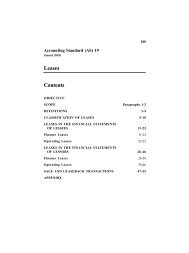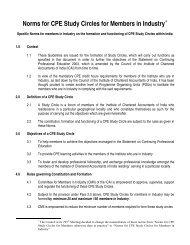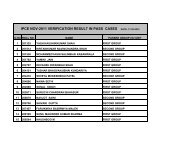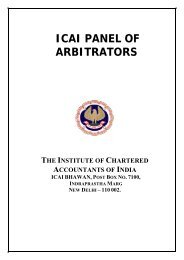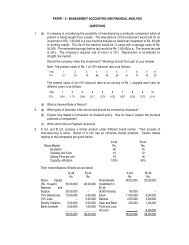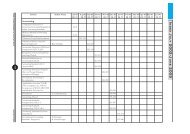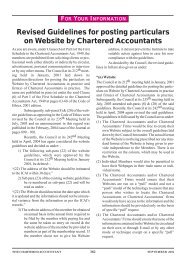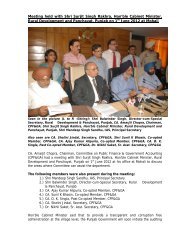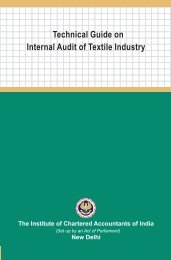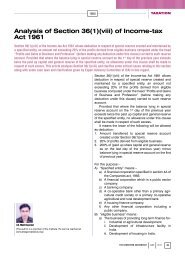The Chartered Accountant
The Chartered Accountant
The Chartered Accountant
You also want an ePaper? Increase the reach of your titles
YUMPU automatically turns print PDFs into web optimized ePapers that Google loves.
the business, to an entity’s ability<br />
to continue its business, or<br />
to avoid material penalties (for<br />
example, compliance with the<br />
terms of an operating license,<br />
compliance with regulatory solvency<br />
requirements, or compliance<br />
with environmental regulations);<br />
non-compliance with<br />
such laws and regulations may<br />
therefore have a material effect<br />
on the financial statements (see<br />
paragraph 14).<br />
7. In this SA, differing requirements<br />
are specified for each of the above<br />
categories of laws and regulations.<br />
For the category referred to in paragraph<br />
6(a), the auditor’s responsibility<br />
is to obtain sufficient appropriate<br />
audit evidence about compliance with<br />
the provisions of those laws and regulations.<br />
For the category referred to in<br />
paragraph 6(b), the auditor’s responsibility<br />
is limited to undertaking specified<br />
audit procedures to help identify<br />
non-compliance with those laws and<br />
regulations that may have a material<br />
effect on the financial statements.<br />
8. <strong>The</strong> auditor is required by this<br />
SA to remain alert to the possibility<br />
that other audit procedures applied<br />
for the purpose of forming an opinion<br />
on financial statements may bring<br />
instances of identified or suspected<br />
non-compliance to the auditor’s attention.<br />
Maintaining an attitude of<br />
professional skepticism throughout<br />
the audit, as required by proposed SA<br />
200 (Revised), 4 is important in this<br />
context, given the extent of laws and<br />
regulations that affect the entity.<br />
Effective Date<br />
9. This SA is effective for audits of<br />
financial statements for periods beginning<br />
on or after April 1, 2009.<br />
Objectives<br />
10. <strong>The</strong> objectives of the auditor are:<br />
(a) To obtain sufficient appropriate<br />
audit evidence regarding compliance<br />
with the provisions of<br />
those laws and regulations generally<br />
recognised to have a direct<br />
effect on the determination of<br />
material amounts and disclosures<br />
in the financial statements;<br />
(b) To perform specified audit<br />
DECEMBER 2008 1086 THE CHARTERED ACCOUNTANT<br />
STANDARDS<br />
procedures to help identify<br />
instances of non-compliance<br />
with other laws and regulations<br />
that may have a material effect<br />
on the financial statements; and<br />
(c) To respond appropriately to noncompliance<br />
or suspected noncompliance<br />
with laws and regulations<br />
identified during the audit.<br />
Definition<br />
11. For the purposes of this SA, the<br />
following term has the meaning attributed<br />
below:<br />
Non-compliance – Acts of omission<br />
or commission by the entity, either<br />
intentional or unintentional, which<br />
are contrary to the prevailing laws or<br />
regulations. Such acts include transactions<br />
entered into by, or in the name<br />
of, the entity, or on its behalf, by those<br />
charged with governance, management<br />
or employees. Non-compliance<br />
does not include personal misconduct<br />
(unrelated to the business activities of<br />
the entity) by those charged with governance,<br />
management or employees<br />
of the entity.<br />
Requirements<br />
<strong>The</strong> Auditor’s Consideration of<br />
Compliance with Laws and Regulations<br />
12. As part of obtaining an understanding<br />
of the entity and its environment<br />
in accordance with SA 315, 5 the<br />
auditor shall obtain a general understanding<br />
of:<br />
(a) <strong>The</strong> legal and regulatory framework<br />
applicable to the entity<br />
and the industry or sector in<br />
which the entity operates; and<br />
(b) How the entity is complying with<br />
that framework. (Ref: Para. A7)<br />
13. <strong>The</strong> auditor shall obtain sufficient<br />
appropriate audit evidence regarding<br />
compliance with the provisions<br />
of those laws and regulations generally<br />
recognised to have a direct effect<br />
on the determination of material<br />
amounts and disclosures in the financial<br />
statements. (Ref: Para. A8)<br />
14. <strong>The</strong> auditor shall perform the following<br />
audit procedures to help identify<br />
instances of non-compliance with<br />
other laws and regulations that may<br />
have a material effect on the financial<br />
4 See footnote 2.<br />
5 SA 315, “Identifying and Assessing the Risks of Material Misstatement Through Understanding the Entity and Its Environment”, paragraph 11.<br />
statements:<br />
(a) Inquiring of management<br />
and, where appropriate, those<br />
charged with governance, as to<br />
whether the entity is in compliance<br />
with such laws and regulations;<br />
and<br />
(b) Inspecting correspondence, if<br />
any, with the relevant licensing<br />
or regulatory authorities.<br />
(Ref: Para. A9-A10)<br />
15. During the audit, the auditor shall<br />
remain alert to the possibility that other<br />
audit procedures applied may bring<br />
instances of non-compliance or suspected<br />
non-compliance with laws and<br />
regulations to the auditor’s attention.<br />
(Ref: Para. A11)<br />
16. <strong>The</strong> auditor shall request management<br />
and, where appropriate, those<br />
charged with governance to provide<br />
written representations that all known<br />
instances of non-compliance or suspected<br />
non-compliance with laws and<br />
regulations whose effects should be<br />
considered when preparing financial<br />
statements have been disclosed to the<br />
auditor. (Ref: Para. A12)<br />
17. In the absence of identified or<br />
suspected non-compliance, the auditor<br />
is not required to perform audit<br />
procedures regarding the entity’s<br />
compliance with laws and regulations,<br />
other than those set out in paragraphs<br />
12-16.<br />
Audit Procedures When Non-<br />
Compliance is Identified or Suspected<br />
18. If the auditor becomes aware of<br />
information concerning an instance of<br />
non-compliance or suspected non-compliance<br />
with laws and regulations, the<br />
auditor shall obtain: (Ref: Para. A13)<br />
(a) An understanding of the nature<br />
of the act and the circumstances<br />
in which it has occurred; and<br />
(b) Further information to evaluate<br />
the possible effect on the financial<br />
statements. (Ref: Para. A14)<br />
19. If the auditor suspects there may<br />
be non-compliance, the auditor shall<br />
discuss the matter with management<br />
and, where appropriate, those charged<br />
with governance. If management or,<br />
as appropriate, those charged with



